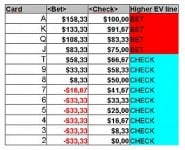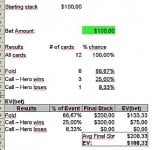You are using an out of date browser. It may not display this or other websites correctly.
You should upgrade or use an alternative browser.
You should upgrade or use an alternative browser.
R
rhombus
Legend
Silver Level
I would absolutely love to take part in this, but my math is baaaaaaaaaaaaad, I mean reallllly baaaaaaaaaaaaaaad.
Wish I wasn't at the back at the queue when the brains were given out
Maybe you was at the front of the queue for something else
R
rhombus
Legend
Silver Level
I hope that you all find the book more useful than I did. I had no trouble with the math but think there's almost nothing of value in the book.
-HooDooKoo
Which book would you recommend if not this one. Moshmans The Math of Holdem ??
Fknife
Legend
Silver Level
we should probably not our overall EV in this game is very very high. EV of bluffing seems small compared to EV of having higher cards. but a 17% edge on a pot is substantial in poker
How do we find a Nash Equilibrium for this game? I'm still a bit clueless as far as that type of stuff goes...
I assume Villain would have to pick some kind of a mixed strategy which would make Hero indifferent to bluffing: defending 50% (given the pot odds) of his entire checking range. He could defend top X% of his hands and add some % of his bluffcatchers => he can accomplish this in several ways. Then we pick the best counter strategy for Hero and...if Villain cannot improve his EV (pick another strategy for defending)...we found the equilibria? Does it make any sense?
Fknife
Legend
Silver Level
Which book would you recommend if not this one. Moshmans The Math of Holdem ??
I've always liked: Owen Gaines - "Poker math that matters". I'm not a math guy, though.
fletchdad
Jammin................
Loyaler
I've always liked: Owen Gaines - "Poker math that matters". I'm not a math guy, though.
You are not a math guy??
shit, then I am fkd.....
R
rhombus
Legend
Silver Level
Is Flopping the FLushIt was just a question on how we got to 1% on probabilities of flopping a flush... But i think i got it.
Im just going to continue reading and skip through anything I don't understand, for now.
Tks
11/50 * 10/49 * 9/48 = 0.008418367
= 0.84% _
R
rhombus
Legend
Silver Level
I've always liked: Owen Gaines - "Poker math that matters". I'm not a math guy, though.
maybe we should have started on that one LOL, as the Bill Chen one looks really hard
R
rhombus
Legend
Silver Level
You are not a math guy??
shit, then I am fkd.....
LOL, like the blind leading the blind.
To me sometimes some of the maths stuff is like reading a sentence in a foreign language, you know some of the words and try and guess what they are on about
Fknife
Legend
Silver Level
You are not a math guy??
shit, then I am fkd.....
Lol, Jay I love your posts and your sense of humor !
Naah, I was always that "average guy" as far as university math related classes went. I dont even like math that much, tbh. I just find some things interesting and worth getting to know, thats all.
maybe we should have started on that one LOL, as the Bill Chen one looks really hard
We have lots of great and smart people here at CC willing to help so I think we'll crush Chen's book easily. Ask, if you dont understand something. You can also come back here later after you finish Owen's book. I'm not planning on going anywhere so there is not rush
Last edited:
ckingriches
Lucky Multiple League MVP
Silver Level
Yes, that is correct.Is Flopping the FLush
11/50 * 10/49 * 9/48 = 0.008418367
= 0.84% _
Just checking in to subscribe to this thread. I don't own the book and have four others that I can't afford to invest the time in right now. But I'll be around to see how this progresses.
EvertonGirl
Professional Fish
Loyaler
LOL, like the blind leading the blind.
To me sometimes some of the maths stuff is like reading a sentence in a foreign language, you know some of the words and try and guess what they are on about
+
That is exactly how I view maths, like I am reading a foreign language
Fknife
Legend
Silver Level
I've always liked: Owen Gaines - "Poker math that matters". I'm not a math guy, though.
Actually...this math video series is better: CLICK (this video + the other ones in that series)
I should have linked to it in the opening post... Ok, end of offtop, back to Chen
R
rhombus
Legend
Silver Level
In Chapter 2 on Variance
maybe I have a misprint in my version (1/16) it says re dice game
You get 5 to 1 and dive roll has higher variamce than flipping coin.
1/16 of the time, you get a payout that is 5 units away from the expectation, while 5/6 of the time you get a payout that is only 1 unit away from the expectation.
When it says expectation, is that 6 and should the paragraph above be the other way round, i.e. 1/6 of the time you win so why is it 5 units away from expectation
or is expectation 1, then the above makes sense, 1/6 your payout is 6 so is 5 away from 1 and 5/6 your payout is 0 so 1 away
maybe I have a misprint in my version (1/16) it says re dice game
You get 5 to 1 and dive roll has higher variamce than flipping coin.
1/16 of the time, you get a payout that is 5 units away from the expectation, while 5/6 of the time you get a payout that is only 1 unit away from the expectation.
When it says expectation, is that 6 and should the paragraph above be the other way round, i.e. 1/6 of the time you win so why is it 5 units away from expectation
or is expectation 1, then the above makes sense, 1/6 your payout is 6 so is 5 away from 1 and 5/6 your payout is 0 so 1 away
Fknife
Legend
Silver Level
maybe I have a misprint in my version (1/16) it says re dice game
You get 5 to 1 and dive roll has higher variamce than flipping coin.
1/16 of the time, you get a payout that is 5 units away from the expectation, while 5/6 of the time you get a payout that is only 1 unit away from the expectation.
When it says expectation, is that 6 and should the paragraph above be the other way round, i.e. 1/6 of the time you win so why is it 5 units away from expectation
or is expectation 1, then the above makes sense, 1/6 your payout is 6 so is 5 away from 1 and 5/6 your payout is 0 so 1 away
Naah, the expectation (EV) is 0. Its a fair die roll. Variance describes how far a set of numbers can be spread out from the expectation (EV; they also use the term: mean). In a die roll example, you can either win 5 (1/6 of time) or lose 1 (5/6 of time). So the variance is: 5.
You're already in Chapter 2?
Figaroo2
Legend
Bronze Level
Great Stuff Martin
(This is helping me)
I take it the old school way of checking medium strength hands on the river is based on this math?
So I presume against weaker players in modern day micro stakes games who can't fold or fold less readily, that betting medium strength hands for thiiiin value is correct because they call with their weaker hands too much thus making it a higher EV for us to bet our medium hands?
(This is helping me)
I take it the old school way of checking medium strength hands on the river is based on this math?
So I presume against weaker players in modern day micro stakes games who can't fold or fold less readily, that betting medium strength hands for thiiiin value is correct because they call with their weaker hands too much thus making it a higher EV for us to bet our medium hands?
R
rhombus
Legend
Silver Level
Thanks got thrown by the 1/16 at first then when it said payout is 5 away from expectation. I thought Payout was 6.Naah, the expectation (EV) is 0. Its a fair die roll. Variance describes how far a set of numbers can be spread out from the expectation (EV; they also use the term: mean). In a die roll example, you can either win 5 (1/6 of time) or lose 1 (5/6 of time). So the variance is: 5.
You're already in Chapter 2?
When you bet at odds of 5 to 1 you get 6 back including your stake so that would be 6 away from Expectation/EV.
So on this occasion does payout mean just the winnings.
Chapter 2 only just started it
Didnt fully understand Chapter 1 but waiitng for others to ask and review questions
Fknife
Legend
Silver Level
Great Stuff Martin
(This is helping me)
I take it the old school way of checking medium strength hands on the river is based on this math?
So I presume against weaker players in modern day micro stakes games who can't fold or fold less readily, that betting medium strength hands for thiiiin value is correct because they call with their weaker hands too much thus making it a higher EV for us to bet our medium hands?
Yea, so if the Villain decides to bluffcatch more, Hero should stop bluffing (because he would be only losing money on his bluffs) and just switch to a depolarized value range. This is how his EV looks like, if Villain bluffcatches [6 - A].

Its a simple game, but it actually teaches some basic concepts. I'm working on finding an Equilibria for it...
R
rhombus
Legend
Silver Level
Re your excellent post on 1st page. Ps i think you was bluffing when you said you aint a maths guy 
https://www.cardschat.com/forum/cas...cs-poker-study-group-260067/post-2570674.html
I actually tried to recreate your table using EV calculations in Excel.
I managed to get all the Check Calcualtions correct but the Bet ones I was unsure, I was looking for a calculation that I could enter in 1 cell then copy down like I used for the Check column
Also one of your calcualtions for Betting with a 9
<9, bet> = (7/12) * $100 + (5/12) * [(0/5) * $200)] + (5/12) * [(5/5) * -$100] = $16.6
Couldn't you just use =(100*7/12)-(100*5/12) as you dont need to calulate the other part as everything above 9 calls and we lose to them all.
One other thing which was slightly confusing
C - amount of hands villain calls with
F - amount of hands villain folds
W - amount of hands we beat (slightly confusing)
L - amount of hands we lose to
Amount of hands we beat is that just for the hands when we are called as it looks like you used that in the calculation or hands we beat i.e. 12 if we have an Ace
https://www.cardschat.com/forum/cas...cs-poker-study-group-260067/post-2570674.html
I actually tried to recreate your table using EV calculations in Excel.
I managed to get all the Check Calcualtions correct but the Bet ones I was unsure, I was looking for a calculation that I could enter in 1 cell then copy down like I used for the Check column
Also one of your calcualtions for Betting with a 9
<9, bet> = (7/12) * $100 + (5/12) * [(0/5) * $200)] + (5/12) * [(5/5) * -$100] = $16.6
Couldn't you just use =(100*7/12)-(100*5/12) as you dont need to calulate the other part as everything above 9 calls and we lose to them all.
One other thing which was slightly confusing
C - amount of hands villain calls with
F - amount of hands villain folds
W - amount of hands we beat (slightly confusing)
L - amount of hands we lose to
Amount of hands we beat is that just for the hands when we are called as it looks like you used that in the calculation or hands we beat i.e. 12 if we have an Ace
Fknife
Legend
Silver Level
Thanks got thrown by the 1/16 at first then when it said payout is 5 away from expectation. I thought Payout was 6.
When you bet at odds of 5 to 1 you get 6 back including your stake so that would be 6 away from Expectation/EV.
So on this occasion does payout mean just the winnings.
If payout was 6, your EV would be: -1 * (5/6) + 6 * (1/6) = 0.16 so you would actually "make" money on it.
Look at it that way: you have $6. You bet 5 times $1 which you lose (5/6 of the time) so your net win is -$5. Then you bet your last $1 and ... you win $5 (1/6 of the time) so now your net win is $0 and you're back to your starting $6. The expectation (mean) was always $0 but the furthest you got from it, was with $5 (Variance).
R
rhombus
Legend
Silver Level
If payout was 6, your EV would be: -1 * (5/6) + 6 * (1/6) = 0.16 so you would actually "make" money on it.
Look at it that way: you have $6. You bet 5 times $1 which you lose (5/6 of the time) so your net win is -$5. Then you bet your last $1 and ... you win $5 (1/6 of the time) so now your net win is $0 and you're back to your starting $6. The expectation (mean) was always $0 but the furthest you got from it, was with $5 (Variance).
Sorry for confusion I understand you either win 5 or lose 1 and on 6 occasions the EV =0, what I meant from a betting point of view is when you bet on a 5 to 1 your payout is 6 when you go to the cashier.
5 Profit and 1 from your initial stake. I meant maybe the wording was confusing or maybe we view payout as different
Fknife
Legend
Silver Level
[/U]Couldn't you just use =(100*7/12)-(100*5/12) as you dont need to calulate the other part as everything above 9 calls and we lose to them all.
Yea, I know its always 0 when we are in that part of our range (we're not beating anything) but if I removed that part, you (and others) would have to remember about adding it on your own.
Correct.[..]
Amount of hands we beat is that just for the hands when we are called as it looks like you used that in the calculation or hands we beat i.e. 12 if we have an Ace
I just created a simple table and for each card in our range, I was basically changing the amount of cards in Villian's range which: fold and win/lose when called (they all sum up to 12) and then just copying the EV into the separate table. Same goes with <Check>.I actually tried to recreate your table using EV calculations in Excel.
R
rhombus
Legend
Silver Level
here was one I got after a few initial mistakes using your equations although slighlty shortened as I used helper columns F and G. Also mine is upside down LOL
Check Column was
B3 =(F3/12*100+(G3/12*0)) then copied down
Bet Column
=(100*D3)+(E3*(H3/5)*200)+(E3*I3/5)*-100 copied down to C10 then had to amend /5 to /4 for the card removal part if you had a T J Q K A
Villain calls
=5/12 copied down to 9s and then changed to 4/12 for T J Q K A
Villain Folds is just 1-Villain Calls
PS I do like the idea of these smaller games as it gives you a chance to think and solve the tiny part of the mass universe of what is POKER
Check Column was
B3 =(F3/12*100+(G3/12*0)) then copied down
Bet Column
=(100*D3)+(E3*(H3/5)*200)+(E3*I3/5)*-100 copied down to C10 then had to amend /5 to /4 for the card removal part if you had a T J Q K A
Villain calls
=5/12 copied down to 9s and then changed to 4/12 for T J Q K A
Villain Folds is just 1-Villain Calls
PS I do like the idea of these smaller games as it gives you a chance to think and solve the tiny part of the mass universe of what is POKER













